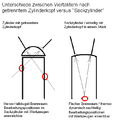Sack cylinder

A bag cylinder is a component in internal combustion engines ; it is manufactured in one piece as a cylinder and cylinder head in one piece, mostly as a cast part with mechanical processing.
To avoid failure-prone cylinder head gaskets , bag cylinders were often chosen in the early decades of engine construction. Their production is not easy, especially in the case of four-stroke engines , and advantageous combustion chamber shapes can hardly be produced with the relatively small possible valve angles; this is prevented by the space required for the processing tools, depending on the length of the bag cylinder (see sketch).
Bag cylinders were built for both air-cooled and water-cooled engines. In the case of water-cooled engines, the cylinder was partially provided with a sheet metal jacket to guide the cooling water. See also Mercedes-Benz MB 518 . One of the last car models with this design was the Panhard 24 , which was built until 1967 .
The pictures show a sack cylinder of an NSU with an IOE engine (“Inlet over Exhaust”; inlet valve above the exhaust valve) around the year of construction 1917. It is the front cylinder of a two-cylinder V-engine.





